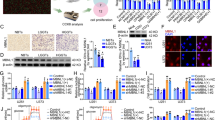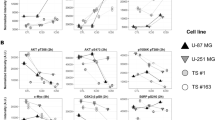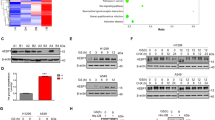Abstract
PEA-15 (phosphoprotein enriched in astrocytes 15 kDa) is a death effector domain-containing protein, which is involved in the regulation of apoptotic cell death. Since PEA-15 is highly expressed in cells of glial origin, we studied the role of PEA-15 in human malignant brain tumors. Immunohistochemical analysis of PEA-15 expression shows strong immunoreactivity in astrocytomas and glioblastomas. Phosphorylation of PEA-15 at Ser116 is found in vivo in perinecrotic areas in glioblastomas and in vitro after glucose deprivation of glioblastoma cells. Overexpression of PEA-15 induces a marked resistance against glucose deprivation-induced apoptosis, whereas small interfering RNA (siRNA)-mediated downregulation of endogenous PEA-15 results in the sensitization to glucose withdrawal-mediated cell death. This antiapoptotic activity of PEA-15 under low glucose conditions depends on its phosphorylation at Ser116. Moreover, siRNA-mediated knockdown of PEA-15 abolishes the tumorigenicity of U87MG glioblastoma cells in vivo. PEA-15 regulates the level of phosphorylated extracellular-regulated kinase (ERK)1/2 in glioblastoma cells and the PEA-15-dependent protection from glucose deprivation-induced cell death requires ERK1/2 signaling. PEA-15 transcriptionally upregulates the Glucose Transporter 3, which is abrogated by the inhibition of ERK1/2 phosphorylation. Taken together, our findings suggest that Ser116-phosphorylated PEA-15 renders glioma cells resistant to glucose deprivation-mediated cell death as encountered in poor microenvironments, for example in perinecrotic areas of glioblastomas.
This is a preview of subscription content, access via your institution
Access options
Subscribe to this journal
Receive 50 print issues and online access
$259.00 per year
only $5.18 per issue
Buy this article
- Purchase on Springer Link
- Instant access to full article PDF
Prices may be subject to local taxes which are calculated during checkout





Similar content being viewed by others
References
Araujo H, Danziger N, Cordier J, Glowinski J, Chneiweiss H . (1993). Characterization of PEA-15, a major substrate for protein kinase C in astrocytes. J Biol Chem 268: 5911–5920.
Bartholomeusz C, Itamochi H, Nitta M, Saya H, Ginsberg MH, Ueno NT . (2006). Antitumor effect of E1A in ovarian cancer by cytoplasmic sequestration of activated ERK by PEA15. Oncogene 25: 79–90.
Boulos S, Meloni BP, Arthur PG, Majda B, Bojarski C, Knuckey NW . (2007). Evidence that intracellular cyclophilin A and cyclophilin A/CD147 receptor-mediated ERK1/2 signalling can protect neurons against in vitro oxidative and ischemic injury. Neurobiol Dis 25: 54–64.
Chou FL, Hill JM, Hsieh JC, Pouyssegur J, Brunet A, Glading A et al. (2003). PEA-15 binding to ERK1/2 MAPKs is required for its modulation of integrin activation. J Biol Chem 278: 52587–52597.
Condorelli G, Trencia A, Vigliotta G, Perfetti A, Goglia U, Cassese A et al. (2002). Multiple members of the mitogen-activated protein kinase family are necessary for PED/PEA-15 anti-apoptotic function. J Biol Chem 277: 11013–11018.
Condorelli G, Vigliotta G, Cafieri A, Trencia A, Andalo P, Oriente F et al. (1999). PED/PEA-15: an anti-apoptotic molecule that regulates FAS/TNFR1-induced apoptosis. Oncogene 18: 4409–4415.
Condorelli G, Vigliotta G, Iavarone C, Caruso M, Tocchetti CG, Andreozzi F et al. (1998). PED/PEA-15 gene controls glucose transport and is overexpressed in type 2 diabetes mellitus. EMBO J 17: 3858–3866.
Danziger N, Yokoyama M, Jay T, Cordier J, Glowinski J, Chneiweiss H . (1995). Cellular expression, developmental regulation, and phylogenic conservation of PEA-15, the astrocytic major phosphoprotein and protein kinase C substrate. J Neurochem 64: 1016–1025.
Del Duca D, Werbowetski T, Del Maestro RF . (2004). Spheroid preparation from hanging drops: characterization of a model of brain tumor invasion. J Neurooncol 67: 295–303.
Dong G, Loukinova E, Chen Z, Gangi L, Chanturita TI, Liu ET et al. (2001). Molecular profiling of transformed and metastatic murine squamous carcinoma cells by differential display and cDNA microarray reveals altered expression of multiple genes related to growth, apoptosis, angiogenesis, and the NF-kappaB signal pathway. Cancer Res 61: 4797–4808.
Elstrom RL, Bauer DE, Buzzai M, Karnauskas R, Harris MH, Plas DR et al. (2004). Akt stimulates aerobic glycolysis in cancer cells. Cancer Res 64: 3892–3899.
Estelles A, Charlton CA, Blau HM . (1999). The phosphoprotein protein PEA-15 inhibits Fas- but increases TNF-R1-mediated caspase-8 activity and apoptosis. Dev Biol 216: 16–28.
Formisano P, Perruolo G, Libertini S, Santopietro S, Troncone G, Raciti GA et al. (2005). Raised expression of the antiapoptotic protein ped/pea-15 increases susceptibility to chemically induced skin tumor development. Oncogene 24: 7012–7021.
Formstecher E, Ramos JW, Fauquet M, Calderwood DA, Hsieh JC, Canton B et al. (2001). PEA-15 mediates cytoplasmic sequestration of ERK MAP kinase. Dev Cell 1: 239–250.
Gillies RJ, Didier N, Denton M . (1986). Determination of cell number in monolayer cultures. Anal Biochem 159: 109–113.
Hao C, Beguinot F, Condorelli G, Trencia A, Van Meir EG, Yong VW et al. (2001). Induction and intracellular regulation of tumor necrosis factor-related apoptosis-inducing ligand (TRAIL) mediated apoptosis in human malignant glioma cells. Cancer Res 61: 1162–1170.
Karcher S, Steiner HH, Ahmadi R, Zoubaa S, Vasvari G, Bauer H et al. (2006). Different angiogenic phenotypes in primary and secondary glioblastomas. Int J Cancer 118: 2182–2189.
Kitsberg D, Formstecher E, Fauquet M, Kubes M, Cordier J, Canton B et al. (1999). Knock-out of the neural death effector domain protein PEA-15 demonstrates that its expression protects astrocytes from TNFalpha-induced apoptosis. J Neurosci 19: 8244–8251.
Krueger J, Chou FL, Glading A, Schaefer E, Ginsberg MH . (2005). Phosphorylation of phosphoprotein enriched in astrocytes (PEA-15) regulates extracellular signal-regulated kinase-dependent transcription and cell proliferation. Mol Biol Cell 16: 3552–3561.
Kubes M, Cordier J, Glowinski J, Girault JA, Chneiweiss H . (1998). Endothelin induces a calcium-dependent phosphorylation of PEA-15 in intact astrocytes: identification of Ser104 and Ser116 phosphorylated, respectively, by protein kinase C and calcium/calmodulin kinase II in vitro. J Neurochem 71: 1307–1314.
Nelson DA, Tan TT, Rabson AB, Anderson D, Degenhardt K, White E . (2004). Hypoxia and defective apoptosis drive genomic instability and tumorigenesis. Genes Dev 18: 2095–2107.
Nishioka T, Oda Y, Seino Y, Yamamoto T, Inagaki N, Yano H et al. (1992). Distribution of the glucose transporters in human brain tumors. Cancer Res 52: 3972–3979.
Ramos JW, Hughes PE, Renshaw MW, Schwartz MA, Formstecher E, Chneiweiss H et al. (2000). Death effector domain protein PEA-15 potentiates Ras activation of extracellular signal receptor-activated kinase by an adhesion-independent mechanism. Mol Biol Cell 11: 2863–2872.
Ramos JW, Kojima TK, Hughes PE, Fenczik CA, Ginsberg MH . (1998). The death effector domain of PEA-15 is involved in its regulation of integrin activation. J Biol Chem 273: 33897–33900.
Renault-Mihara F, Beuvon F, Iturrioz X, Canton B, De Bouard S, Leonard N et al. (2006). PEA-15 expression inhibits astrocyte migration by a PKC delta-dependent mechanism. Mol Biol Cell 17: 5141–5152.
Renganathan H, Vaidyanathan H, Knapinska A, Ramos JW . (2005). Phosphorylation of PEA-15 switches its binding specificity from ERK/MAPK to FADD. Biochem J 390: 729–735.
Ricci-Vitiani L, Pedini F, Mollinari C, Condorelli G, Bonci D, Bez A et al. (2004). Absence of caspase 8 and high expression of PED protect primitive neural cells from cell death. J Exp Med 200: 1257–1266.
Rong Y, Durden DL, Van Meir EG, Brat DJ . (2006). ‘Pseudopalisading’ necrosis in glioblastoma: a familiar morphologic feature that links vascular pathology, hypoxia, and angiogenesis. J Neuropathol Exp Neurol 65: 529–539.
Sharif A, Renault F, Beuvon F, Castellanos R, Canton B, Barbeito L et al. (2004). The expression of PEA-15 (phosphoprotein enriched in astrocytes of 15 kDa) defines subpopulations of astrocytes and neurons throughout the adult mouse brain. Neuroscience 126: 263–275.
Song JH, Bellail A, Tse MC, Yong VW, Hao C . (2006). Human astrocytes are resistant to Fas ligand and tumor necrosis factor-related apoptosis-inducing ligand-induced apoptosis. J Neurosci 26: 3299–3308.
Stassi G, Garofalo M, Zerilli M, Ricci-Vitiani L, Zanca C, Todaro M et al. (2005). PED mediates AKT-dependent chemoresistance in human breast cancer cells. Cancer Res 65: 6668–6675.
Todaro M, Zerilli M, Ricci-Vitiani L, Bini M, Perez Alea M, Maria Florena A et al. (2006). Autocrine production of interleukin-4 and interleukin-10 is required for survival and growth of thyroid cancer cells. Cancer Res 66: 1491–1499.
Trencia A, Perfetti A, Cassese A, Vigliotta G, Miele C, Oriente F et al. (2003). Protein kinase B/Akt binds and phosphorylates PED/PEA-15, stabilizing its antiapoptotic action. Mol Cell Biol 23: 4511–4521.
Vigliotta G, Miele C, Santopietro S, Portella G, Perfetti A, Maitan MA et al. (2004). Overexpression of the ped/pea-15 gene causes diabetes by impairing glucose-stimulated insulin secretion in addition to insulin action. Mol Cell Biol 24: 5005–5015.
Whitehurst AW, Robinson FL, Moore MS, Cobb MH . (2004). The death effector domain protein PEA-15 prevents nuclear entry of ERK2 by inhibiting required interactions. J Biol Chem 279: 12840–12847.
Xiao C, Yang BF, Asadi N, Beguinot F, Hao C . (2002). Tumor necrosis factor-related apoptosis-inducing ligand-induced death-inducing signaling complex and its modulation by c-FLIP and PED/PEA-15 in glioma cells. J Biol Chem 277: 25020–25025.
Ziegler A, von Kienlin M, Decorps M, Remy C . (2001). High glycolytic activity in rat glioma demonstrated in vivo by correlation peak 1H magnetic resonance imaging. Cancer Res 61: 5595–5600.
Acknowledgements
This work was supported by a grant from the Deutsche Krebshilfe to WR (German Cancer Aid, Max Eder Program). We thank Ilona Demir and Karina Zipp for expert technical assistance and Christine Golde and Ulrike Lemke for advice.
Author information
Authors and Affiliations
Corresponding author
Additional information
Supplementary Information accompanies the paper on the Oncogene website (http://www.nature.com/onc).
Supplementary information
Rights and permissions
About this article
Cite this article
Eckert, A., Böck, B., Tagscherer, K. et al. The PEA-15/PED protein protects glioblastoma cells from glucose deprivation-induced apoptosis via the ERK/MAP kinase pathway. Oncogene 27, 1155–1166 (2008). https://doi.org/10.1038/sj.onc.1210732
Received:
Revised:
Accepted:
Published:
Issue Date:
DOI: https://doi.org/10.1038/sj.onc.1210732
Keywords
This article is cited by
-
Proteomics analysis identifies PEA-15 as an endosomal phosphoprotein that regulates α5β1 integrin endocytosis
Scientific Reports (2021)
-
Kinomic profiling of glioblastoma cells reveals PLCG1 as a target in restricted glucose
Biomarker Research (2018)
-
Role of JMJD2B in colon cancer cell survival under glucose-deprived conditions and the underlying mechanisms
Oncogene (2018)
-
Phosphoprotein enriched in diabetes (PED/PEA15) promotes migration in hepatocellular carcinoma and confers resistance to sorafenib
Cell Death & Disease (2017)
-
Integrin α5β1 and p53 convergent pathways in the control of anti-apoptotic proteins PEA-15 and survivin in high-grade glioma
Cell Death & Differentiation (2016)



